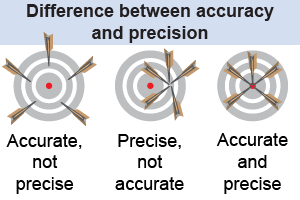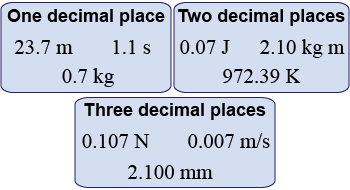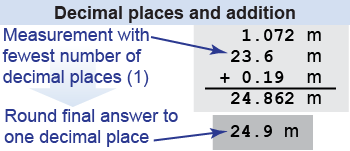|
Quantitative means to express a measurement with a numerical value. Unfortunately, it is impossible to measure the exact true value of any physical quantity. All measurements contain some level of uncertainty. Suppose a balance measures the mass of a coin to be 1.00 g. This measurement does not tell you that the exact mass is 1.00 g because the specifications for the balance allow ±0.02 g of uncertainty! The measurement tells you that the exact mass of the coin lies between 0.98 and 1.02 g. Within the context of measurements, 1.0 and 1.000 are different because they imply different levels of uncertainty. 
|
Accuracy and precision
|
 In science, the words accuracy and precision have different meanings. Precision tells you the repeatability of a sequence of measurements of the same quantity. If you make three measurements of the mass of a coin on a balance precise to 0.1 g then each measurement will be within 0.1 g of the others. Accuracy tells you how close any measurement is to the true value of the quantity being measured. A meter ruler with small, millimeter divisions might be precise, but it would be inaccurate if the ruler were accidentally manufactured with a length of one yard instead of one meter.
In science, the words accuracy and precision have different meanings. Precision tells you the repeatability of a sequence of measurements of the same quantity. If you make three measurements of the mass of a coin on a balance precise to 0.1 g then each measurement will be within 0.1 g of the others. Accuracy tells you how close any measurement is to the true value of the quantity being measured. A meter ruler with small, millimeter divisions might be precise, but it would be inaccurate if the ruler were accidentally manufactured with a length of one yard instead of one meter. 
|
 Every measurement of a physical quantity has an uncertainty associated with it. The uncertainty may be expressed explicitly with a plus-or-minus sign, such as ±0.001 m. A measurement of the length of a table precise to one millimeter could be written as 2.067 ±0.001 m.
Every measurement of a physical quantity has an uncertainty associated with it. The uncertainty may be expressed explicitly with a plus-or-minus sign, such as ±0.001 m. A measurement of the length of a table precise to one millimeter could be written as 2.067 ±0.001 m. 
|
 Precision determines the number of decimal places recorded for measurements. A meter stick is precise to 0.5 mm because the smallest gradations are every millimeter (0.001 m) and you can estimate to one half the smallest gradation. For example, the width of a table might be 885.5 mm. In meters this would be recorded with four decimal places, or 0.8855 m.
Precision determines the number of decimal places recorded for measurements. A meter stick is precise to 0.5 mm because the smallest gradations are every millimeter (0.001 m) and you can estimate to one half the smallest gradation. For example, the width of a table might be 885.5 mm. In meters this would be recorded with four decimal places, or 0.8855 m. 
|
 The results of a calculation can never be more precise than the precision of any of the individual measurements that went into it. When adding or subtracting, round off the final value to the least number of decimal places among the individual measurements.
The results of a calculation can never be more precise than the precision of any of the individual measurements that went into it. When adding or subtracting, round off the final value to the least number of decimal places among the individual measurements. 
|
One financial services company claims that it can provide the most precise measurement of a market index (such as the S&P 500® Index) at any given time, while another company claims it can provide the most accurate value. Assuming both claims are true, then which service is better? Most people will likely prefer the more accurate service, since knowing the value to five decimal places is unnecessary—but knowing how much money you have, within a factor of 2, is important! 
|
Which measurement for the height of a person is the most precise? - 2 m
- 0.0015 km
- 160 cm
- 1790 mm
 |
The correct answer is d, 1790 mm. If you convert them all into meters, then d has three decimal places, while the rest have between zero and two, so it is the most precise. 
|

